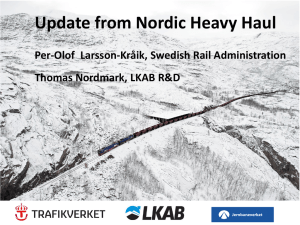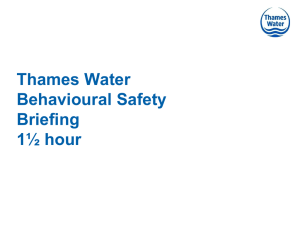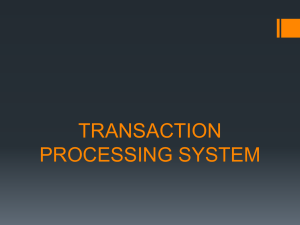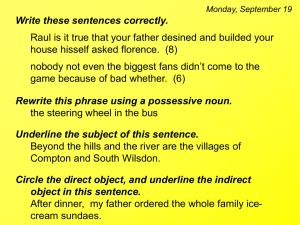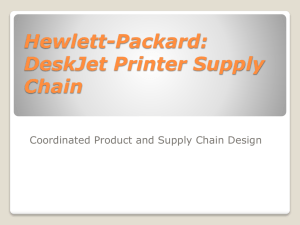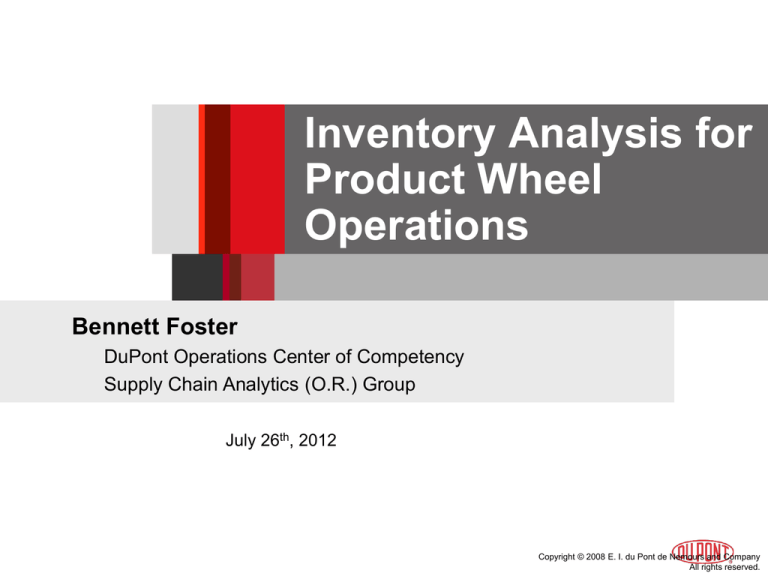
Inventory Analysis for
Product Wheel
Operations
Bennett Foster
DuPont Operations Center of Competency
Supply Chain Analytics (O.R.) Group
July 26th, 2012
Copyright © 2008 E. I. du Pont de Nemours and Company
All rights reserved.
Acknowledgements – DuPont Colleagues
Pete King
Alev Kaya
Cris Leyson
2
Product Wheels
Purpose
To understand how inventory is calculated
and impacts cost when running product
wheels.
Process
Review of product wheels, safety stock
calculations, and replenishment lead time
“risk” considerations
Product
Basic understanding of inventory and
inventory cost calculations when running
product wheels
3
Contents
Product Wheels and Inventory
The Basics
Managing Principles
Safety stock calculations
Safety stock versus product wheel length
Inventory calculations for supply chain networks
4
Product Wheel: The Basics
Product Wheel - Definition:
Production sequence used by a manufacturing
operation when multiple products are made on
a single line/piece of equipment
Consistent sequence
Repetitive time cycle (approximately the same
time to get around the wheel each cycle)
Caution: Some businesses do not run a repetitive
sequence, but still refer to their planning cycle as
their “product wheel”
5
Concepts & Definitions
TIME WHEN CYCLE
STOCK INVENTORY
FOR B IS NEEDED
TRANSITIONS
IDLE
• The amount of B
produced must be
enough to satisfy
demand of B during
the entire cycle, plus
safety stock make-up
A
D
B
CAMPAIGN
C
TRANSITIONS
BATCHES
• The inventory left at
the end of the B
campaign must be
enough to last
through the remainder
of the cycle until the
next campaign of B
starts.
Batch: Size of one unit of production (in batch processes)
Campaign: “spoke”, length of one segment of a product wheel, or a series of batches of same product
Lot: subsets of campaigns to represent some quality commonality
Cycle: planning length that includes multiple campaigns. Sequence, campaign lengths and gaps need
to be specified.
6
Product Wheel: When should they be used?
Machines running multiple products:
If transitions (setup) are costly in terms of…
Time
Yield loss
Labor
Materials
If transition costs are impacted by sequence
Colors (black to white)
Dimensions (i.e., sheet width)
Material grades
Variations in process parameters (i.e., temperature)
Consider Product Wheels if either of the above conditions are true.
7
Product Wheel: Why?
When managed properly, Product Wheels provide
effective discipline for meeting customer demand &
service levels, while maximizing process
responsiveness and minimizing required inventory
Decreases cash flow cycle time
Decreases controllable fixed costs
Increases variable margin
Provides framework for establishing customer order lead
times (lead time > product wheel length)
Provides understanding of relationship between transition
cost and inventory cost
8
Inventory vs. Product Wheel Length
Product Wheel length:
Annual Demand
D = 1,000 units
Plan A = 4 weeks
Plan B = 1 week
Inventory
Level
400
100
Plan A: Q = 400
Average Stock for
Plan A = 200
Average Stock for
Plan B = 50
Plan B: Q = 100
1 week
4 weeks
How does Product Wheel length impact average cycle
stock?
How does Product Wheel length impact capacity if
product transitions require substantial downtime?
Which plan is better?
9
Time
Concepts & Definitions: Product Wheel Cycle Length
Inventory Level
Cycle Stock
D
A
B
WHEEL TIME
CYCLE LENGTH
C
D
A
B
A
D
B
C
10
Product Wheel: The Basics
Objective:
Maintain shortest reasonable product wheel cycle time
without sacrificing customer service
Why are shorter Product Wheels more desirable?
Require less inventory and reduce wasteful behaviors
Peak Inventory =
Average
Demand
*
Replenishment
Time
*
(1 + Safety )
Factor
Product Wheel Length
11
Product Wheel Length: The Debate
SHORT
Lower inventories
Shorter ‘period of risk’
Increased flexibility –
respond faster to changes
in customer demand
LONG
Fewer transitions = higher
equipment capacity
More stable operations,
potentially higher yields
Perceived by operations as
lowest cost
The balance we must maintain with a product wheel is
transition (setup) cost vs. inventory cost – while meeting
customer service requirements.
12
Concepts & Definitions: End-to-End Supply Chain
Transitions
Production
Facility
A
Idle
Purchase
tm
Raw
Material
Inventory
Ocean or
long
distance
Source
warehouse
D
B
C
t1
Order Lead time
Distribution
Warehouse
t2
Payment
Customer
tp
t3
tc
Total supply lead time= sum of the following
tm = Time from raw material order to receipt in raw material warehouse
tc = Lead time to produce
t1 = Lead time from production to source warehouse
t2 = lead time from source warehouse to distribution warehouse
t3 = Lead time from distribution warehouse to customer
tp = Time from delivery to customer to receipt of payment
Note: All times includes order processing
13
Managing the Product Wheel
In order to properly manage a product wheel, you need
to understand all of the factors that influence the wheel…
Internal Variables
(and their variability)
Number of Products
Transition
Product (D to A)
D
Transition Times
Yield & Rate Losses
Product
A
Transition
(A to B)
Production Rates
Downtime
External Variables
(and their variability)
Product Wheel
Product
B
Transition
(C to D)
Product
C
Demand Rate
Lead Time
Transition
(B to C)
14
Lean Impact on Product Wheel Length
Min. Product
Wheel Length =
Σ Transition Time
n
Uptime –
Σ Production Rate
i
Factor
Effect on
Change
PW Length
Demand Rate i
i
Explanation
Transition
Time
More time available to make
product; spin wheel faster
Uptime
More time available to make
product; spin wheel faster
Demonstrated
Rate
Less time is needed to produce
same amount; shorter wheel
15
Lean Impact on Product Wheel Length
Any improvement that decreases product wheel length
will reduce inventory.
Lean Tool Box: 5S, SMED, TPM, Workplace Redesign,
Activity Waste Analysis, Standard Work and Cell Design
Decrease transition time
Increase uptime
Increase production rate
Cell Design - allocate products across parallel assets
to assign each product to a single asset
Fewer products on each wheel
Shorter, less costly transitions
16
Product Wheel: Design Components
Sequence
Minimize transition cost and time
Focus on transition from family to family
Length
Primary “drivers” for determining length (cycle):
Minimize sum of inventory and transition costs
Inventory costs - capital, insurance, taxes, obsolescence, storage
Sufficient capacity to meet demand
Composition
Every product (family) every cycle?
Some products more or less frequently?
17
Other factors that impact Product Wheel design
Minimum campaign lengths and batch sizes
Sales constraints may strongly influence design
Capability to do transitions – timing, run order, …
Other technical constraints: cleanouts, catalysts, …
Process capability
Unscheduled down time: average and variability
Lead time uncertainty
Volume discounts
Transportation economies
Supplier policy
Multiple-item purchases
18
Inventory
Level
Production Cycle
Slope = Production Rate (m) -Demand rate, (D)
Slope =
Demand rate (D)
Kanban level for a
pull system
Cycle
Stock
Safety
Stock
Time
Product Cycle,
T=Q/A
Production
Campaign
Started
19
Product Wheels – The Case for Spinning Faster
Lower inventory levels mean less investment and lower
inventory carrying costs
Running a product more frequently reduces the likelihood
of stockouts (a fact that is not accounted for in the EOQ
calculations)
From a “Lean” perspective – transition cost and time are
factors to be reduced instead of “accepted” – to make
lower inventories and more frequent transitions an
accepted practice (and a competitive advantage)
20
Product Wheel Calculations – Cycle Stock vs.
Safety Stock
Traditionally, cycle stock and safety stock
calculations are carried out separately
One might imply that the two are independent
They are not!
21
Safety Stock covers “Greater than Average
Demand” during the Period of Risk
Cycle stock (cycle inventory level) depends only
on product wheel length
Safety stock calculated to cover the entire period
of risk – which includes the wheel length, and may
include raw material lead time, shipping time, . . .
(assuming the shipping time does not extend the
delivery time past the next scheduled raw material
ordering date!)
Cycle
Stock
Safety
Stock
Time
22
Grounding on Service Level and Forecast Error
Fundamental Drivers of Safety Stock
Requirements
Inherent variability in demand and supply, along with the
service goals are the drivers of safety stock requirements.
Variability of demand that needs to be accounted in safety
stocks is due to “forecast error” which is often approximated
by variability of historical demand. Using forecast error
instead can make a difference.
Using the correct service level type for the service level
targets is another critical component in determining the
safety stock requirements accurately.
Grounding on Service Level and Forecast Error
Service Level Types
Cycle Service Level, Alpha Service Level (APO), Non
Stock-out Probability (SmartOps)
Service level is shortfall event-oriented
Number of periods with complete delivery fulfillment/total number of
periods
Useful if the customer accepts only complete deliveries (all or
nothing), or if the fixed costs of subsequent deliveries are high
Fill-rate, Beta Service Level (APO)
Service level is shortfall quantity-oriented
Quantity delivered in time/total demand
Useful if the customer also accepts partial deliveries or the fixed
costs of subsequent deliveries are low
Please note that both Cycle Service Level and Fill-rate can be
used when demand is non normal.
Safety Stock
Safety Stock = Z Ravgs D2 +
s R2
2
Bowersox, Logistical Management, 1978
Safety stock for cycle service level for Z value (1tailed Normal coefficient), where:
D is demand during a period
σD is standard deviation of (forecast) demand during a period
R is periods in replenishment lead time, referred to later as
“Period of Risk”. It’s absolute min. value = product wheel length.
σR is standard deviation (in periods) of replenishment lead time R
Note how safety stock increases with product wheel length!
25
The Necessity of
Comparing Forecasts
to Actual
Demand
Safety Stock - STDEV of Demand: If you
Forecast Demand, use STDEV of Forecast
Error
Forecast error is the
difference between
forecast and actual sales
Using standard deviation
of historical demand
substitutes forecast error
by demand variability,
and ignores existing
time-varying forecasts
160
150
140
130
120
110
100
90
80
70
60
Forecast
Actual Demand
Average Demand
0
1
2
3
4
5
6
7
8
9 10 11 12 13
Month
STDEV of Forecast Error = 5.2
STDEV of Historical Demand = 19
Safety Stock - STDEV of Demand: Take out
“Special Cause” Events
It is a business decision on how to mitigate these types
of variability
Special Cause
• Rare and unpredictable
variation
Demand
or supply
Common cause
• Statistically predictable
variation
27
Safety Stock – There to be “Used”
Inventory should be expected to frequently (about
50% of cycles) consume safety stock – and
occasionally (consistent with targeted customer
service level) drop to zero. (Does this “frighten”
anyone???)
D
D
D
1
2
3
28
Cycle Stock and Safety Stock - Related
Product wheel lengths are often
set using some sort of EOQ
related calculation (upper bound
of wheel length!)
Given the fact that EOQ cost
changes slowly as we move away
from the “optimum” – savings in
safety stock may warrant running
shorter (than EOQ) product
wheels!
The cost is more transitions – the
payoff is less inventory (cycle
stock and safety stock) and better
customer service.
29
Cycle Inventory Level
Period of Risk: For how long a period does your
“Make Plan” have to cover demand?
D
A
B
C
D
A
B
WHEEL TIME
CYCLE LENGTH
A
D
If you can change plans right up until production starts
and the product gets to your customer “instantly” (How
likely is that?), then your replenishment lead time is your
wheel length. You’re at risk because you can’t produce
to respond to the market during this “Period of Risk”.
C
30
B
Cycle Inventory Level
Period of Risk: For how long a period does your
“Make Plan” have to cover demand?
D
Order
Raw
Mat’l
A
B
C
D
A
B
WHEEL TIME
CYCLE LENGTH
POR
If there’s a raw material lead time, then once you’ve
ordered raw material, the product you have + make
using the ordered raw material, must cover sales until
the next time you order raw material
Period of Risk = wheel length + raw material lead time
A
D
C
31
B
Cycle Inventory Level
Period of Risk: For how long a period does your
“Make Plan” have to cover demand?
D
Order
Raw
Mat’l
A
B
C
WHEEL TIME
CYCLE LENGTH
D
A
B
Ship
Time
POR
Period of Risk (replenishment lead time) may include
raw material lead time + wheel length + shipping time
(and possibly other times!)
A
D
C
32
B
Cycle Inventory Level
Period of Risk: For how long a period does your
“Make Plan” have to cover demand?
D
A
B
C
D
A
B
A
Order
Raw
Mat’l
WHEEL TIME
CYCLE LENGTH
Ship
Time
D
C
B
Period of Risk
Since all of these time delays impact safety stock
requirements, consider how much they are interrelated.
For instance, stocking long lead time raw materials
could allow you to hold less finished inventory (because
inventorying raw materials can cut out some or all of the
raw material lead time requirement!)
33
Inventory in Supply Chain Networks
The previous slides have concentrated on safety
stock held at one location for demand placed on
that location.
In our modern interconnected world, life is
frequently more complicated! Many times we
need to consider supply networks.
The mathematics can get considerably more
complicated!
34
Inventory in Supply Chain Networks
Simple example:
Assume s and D are the
same for Region A and
Region B (and demand is
normally distributed and
independent between A and
B)
Also assume that the
replenishment lead time
(period of risk) is a constant
1 time unit (month) => time
to produce and ship product
is always exactly 1 month
D
Plant Whs
RegionA Whs
RegionB Whs
35
Inventory in Supply Chain Networks
Plant Whs
If we hold all of the inventory
in regional warehouses, we’ll
need safety stock for each of
the 2 warehouses:
RegionA Whs RegionB Whs
SS = z
σ
2
D
R + D 2 σR 2
Total SS = 2whs * zs
because R=1 and std. dev. of
R=0
D
36
Inventory in Supply Chain Networks
Plant Whs
RegionA Whs RegionB Whs
37
Inventory in Supply Chain Networks
Plant Whs
This simple exercise just
provides an example of what we
knew already – that for a given
set of customers, we can keep
less safety stock the more
customers we serve from the
same warehouse.
38
Inventory in Supply Chain Networks
However, there are lots of reasons
why we need regional warehouses:
Delivery times from the plant
warehouse exceed competitive
order lead times
Plant Whs
Customers want local sourcing
Delivery times are too variable to
RegionA Whs
satisfy customer service
RegionB Whs
requirements
Cheaper to bulk ship to a region
and break apart shipments for
individual shipments to customers
39
Inventory in Supply Chain Networks
Plant Whs
RegionA Whs
RegionB Whs
The analysis gets much
more complex very quickly
when we look at questions
like:
How many regional
warehouses – and where
How much to keep in each
warehouse
Consider trans-shipping
between certain warehouses
for certain customers . . .
40
Inventory in Supply Chain Networks
Plant Whs
RegionA Whs
RegionB Whs
There are commercial tools
that can address these
complex network problems.
Tools that I’m aware of
include:
SmartOps
LamaSoft
APO (limited capability)
41
Inventory in Supply Chain Networks
Plant Whs
RegionB Whs
RegionA Whs
Another approach is to develop
a simulation model of the supply
chain (or potential supply chain):
Test varying locations and
inventory levels at each location
Use an simulation optimizer such
as OPTQUEST to search for
good results with larger problems
Note that for very large
problems, a tool, designed for
solving inventory network
problems, is your best option.
42
Questions?
Comments?
43


